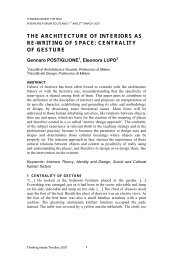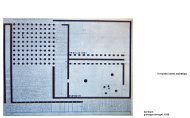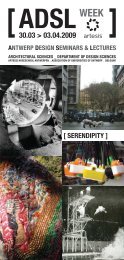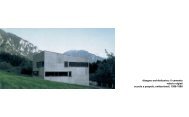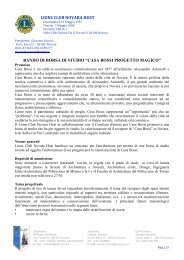the atlantic wall: bunker and/as modern architecture - lablog
the atlantic wall: bunker and/as modern architecture - lablog
the atlantic wall: bunker and/as modern architecture - lablog
You also want an ePaper? Increase the reach of your titles
YUMPU automatically turns print PDFs into web optimized ePapers that Google loves.
So when planning <strong>the</strong> Atlantik Wall began in 1943, concrete represented a better solution for <strong>the</strong> achievement<br />
of its goals, in terms of time needed for <strong>the</strong> realisation, in terms of efficiency of <strong>the</strong> form, <strong>and</strong> in terms of<br />
economising <strong>the</strong> process of project-making. Bunkers were seen <strong>as</strong> <strong>the</strong> perfect typology for interpreting <strong>the</strong><br />
potentiality of concrete <strong>as</strong> recognized by many <strong>modern</strong>ist m<strong>as</strong>ters.<br />
fig. 5: The construction process, from industrialization of <strong>the</strong> design to industrialization of <strong>the</strong> construction<br />
(construction drawing, orig. scale 1:50 © R. Rolf; propag<strong>and</strong>a photo © Bundesarchiv Koblenz/D).<br />
Todt industries compiled <strong>the</strong> Typenheft, a catalogue of all <strong>the</strong> <strong>bunker</strong> types needed to protect <strong>the</strong> Western<br />
Front, which included structures for very diverse goals, from “Comm<strong>and</strong> Post” to “Ammunition <strong>bunker</strong>”,<br />
from “Anti-aircraft foxhole” to “Tobruk”, <strong>and</strong> so forth with hundreds <strong>and</strong> hundreds of different types, each of<br />
<strong>the</strong>m meticulously planned into utmost detail, like an industrial product (Rolf, 1980). Similarly, in fact, to<br />
industrial world, <strong>the</strong> major control process shifted from <strong>the</strong> realisation stage to <strong>the</strong> project making: all<br />
problems were recognised <strong>and</strong> solved right <strong>the</strong>re in order to avoid difficulties at <strong>the</strong> construction (De Fusco,<br />
1996, Pirovano, 1991).<br />
Ano<strong>the</strong>r industrialisation linked to <strong>the</strong> first one is <strong>the</strong> construction itself, related to <strong>the</strong> identification of an<br />
individual warfare product <strong>as</strong> industrial <strong>architecture</strong>: because of <strong>the</strong> absolute correspondence of form to use,<br />
because of <strong>the</strong> elimination of all activities related to housing, <strong>and</strong> because of <strong>the</strong> rigorous productivity of <strong>the</strong><br />
construction (<strong>the</strong> productivity related to its primary function of surveillance <strong>and</strong> protection).<br />
CONCLUSION<br />
The value of <strong>the</strong> immense infr<strong>as</strong>tructure, recognized <strong>as</strong> "industrial heritage" <strong>and</strong> <strong>as</strong> "architectural manufact",<br />
allows <strong>the</strong> rising of new meanings that contribute to promoting its valorisation <strong>and</strong> re-call in life. And, above<br />
all, <strong>the</strong> highlighting of Atlantic Wall remains <strong>as</strong> part of <strong>modern</strong> <strong>architecture</strong> history <strong>and</strong> heritage.<br />
The system of military fortifications constitutes one of <strong>the</strong> greatest European cultural architectonic heritages,<br />
shared geographically, which preserve fragments of <strong>the</strong> collective memory, forming <strong>the</strong> b<strong>as</strong>is for <strong>the</strong><br />
construction of contemporary Europe.<br />
Fur<strong>the</strong>rmore, we are not unaware of <strong>the</strong> embarr<strong>as</strong>sing memory that lies in <strong>the</strong>se buildings - a collective <strong>and</strong><br />
mutual memory, on a European b<strong>as</strong>is, not yet resolved <strong>and</strong> in certain ways postponed. It seems <strong>as</strong> though a<br />
look could rest on <strong>the</strong>se objects, but only under <strong>the</strong> notion of alienated mnemonic drive: memories which<br />
remain firmly imprinted in <strong>the</strong>ir physical structure <strong>and</strong> geographic place.<br />
For that re<strong>as</strong>on it is also necessary to confirm that dealing with <strong>the</strong>se embarr<strong>as</strong>sing warfare products does not<br />
have anything to do with any sort of attempt to rehabilitate those responsible for <strong>the</strong> war or those believing in<br />
it. In fact, we would like to corroborate <strong>the</strong> idea of transforming <strong>the</strong> great Atlantic Wall into a monument<br />
bringing toge<strong>the</strong>r true, positive <strong>and</strong> creative actions, which will enable us once <strong>and</strong> for all to transform <strong>the</strong><br />
mourning <strong>and</strong> keep <strong>the</strong> collective memory preserved in it alive. What are monuments if not instruments that<br />
prevent people from forgetting <strong>and</strong>, at <strong>the</strong> same time, products with <strong>the</strong> t<strong>as</strong>k of preserving <strong>and</strong> h<strong>and</strong>ing down<br />
mutual collective values?<br />
This, in fact, is <strong>the</strong> t<strong>as</strong>k of a monument. This is what The Atlantic Wall should be turn-into.<br />
DOCOMOMOiberico-CADIZ2007_paper postiglione p 5




